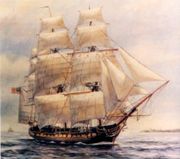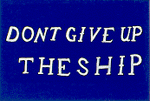US frigate Chesapeake
From WikiPOBia
Chesapeake was the smallest of the original six frigates; fourteen percent smaller than her 44-gun sisters (United States, Constitution, and President) and seven percent smaller than her 38-gun sisters (Constellation and Congress). She acquired a reputation among contemporary sailors as an "unlucky" or "unhappy" ship, mostly because of the 1807 incident in which she was forced to strike colors to the British fourth-rate HMS Leopard after Leopard had fired into her while enforcing a search for British deserters. Chesapeake's poor reputation may also have been partially a product of her officers' dislike of her sailing qualities, which had been described by one of her commanding officers, Stephen Decatur, as "dull." She was also the only frigate of the original six that had not been named for some form or symbol of the new American government.
Contents |
The Quasi-War with France
Chesapeake sailed in 1800 to join the squadron patrolling off the southern coast of the United States and in the West Indies during the Quasi-War with France. During this cruise, she took a French privateer as a prize. One of the few ships retained in the Navy at the close of the war, Chesapeake was sent to the Mediterranean Sea in 1802 as flagship for Commodore Richard V. Morris. Here she led in the blockade of Tripoli and convoyed American merchantmen until 1803, when she returned to America.
Chesapeake - Leopard Affair
As tension mounted over the practice of impressment of American seamen by the British, Chesapeake was prepared for patrol and convoy duty, and late in June 1807 put to sea, passing a British squadron operating to intercept French ships then at Annapolis. British officers had first-hand knowledge that the Chesapeake's crew included at least some deserters from British men-of-war. The British, as a result, were under orders from their commander-in-chief on the North American Station that if Chesapeake was encountered at sea, she was to be stopped and searched for the known deserting British sailors.
One of the British squadron anchored in Lynnhaven Bay, HMS Leopard, followed Chesapeake as she exited Hampton Roads. On 22 June, Leopard stopped Chesapeake off the Virgina capes, and ordered Chesapeake's crew mustered on deck to allow a search for the British deserters. The senior officer aboard Chesapeake, Commodore James Barron, refused. Leopard fired on the Chesapeake, killing three men, wounding 18 (including the captain) and seriously damaging the ship before proceeding to carry off four men identified as British deserters. Chesapeake returned to Norfolk, Virginia for repairs.
Both Commodore Barron and his flag captain were severely criticized for the incident, and were blamed for Chesapeake's inability to make any substantive response to the humiliating attack. Chesapeake had not been cleared for action in time for her guns to be prepared to return hostile fire, and her weaponry was obstructed by the presence of extra cargo, passengers, and convalescing ill crewmembers whose hammocks were slung between the guns of the ship's 18-pound main battery. Barron was court-martialed and excluded from naval service for a period of five years following his trial.
Following repairs, Captain Stephen Decatur took command of the Chesapeake, and cruised off the New England coast. In effort to rehabilitate the frigate's crew following the Leopard incident, and to shame them into fastidious observation of their duties, Decatur initially would not allow Chesapeake to either fire or return salutes. He reasoned that a "ship without honor" was incapable of performing honors.
The anger and public outcry generated in the United States following the Chesapeake-Leopard affair is often cited as one of the aggravating factors that led to the War of 1812.
War of 1812
With the outbreak of the War of 1812, Chesapeake was outfitted at Boston for a lengthy Atlantic cruise. Between December 1812 and April 1813, she cruised from the West Indies to Africa, taking five British merchantmen as prizes.
At Boston, Captain James Lawrence took command of Chesapeake on 20 May 1813. At the time of his appointment to command of Chesapeake, Lawrence was the most junior captain on the U.S. Navy captains list. Lawrence put to sea on 1 June to meet the waiting Shannon (38), the crack frigate commanded by Philip Broke whose written challenge had just missed Chesapeake's sailing.A substantial percentage of Lawrence's crew was new to the ship and undrilled. Lawrence himself had little experience with the ship. He nonetheless chose to engage Shannon, a ship of roughly equal strength, but with a much more experienced and well-drilled crew than the Chesapeake. The Chesapeake suffered early in the exchange of broadsides, having its wheel shot away and losing maneuverability. A large percentage of the officers and crew stationed on the spar deck, including Lawrence himself, were either killed or wounded in the initial exchange of broadsides and small arms fire. Lawrence was carried below, mortally wounded. The crew struggled to carry out Lawrence's last order, "Don't give up the ship! Fight her until she sinks!", but were boarded by the Shannon's crew and overwhelmed. Chesapeake was taken to Halifax for repairs, and was later taken into the Royal Navy. She was sold at Plymouth in 1820 and broken up. Some of her timbers were used to build Chesapeake Mill, a water mill in Wickham, Hampshire.
| SPOILER WARNING: Plot or ending details for "The Fortune of War and The Surgeon's Mate" follow. |
In the Canon
In The Fortune of War, Jack Aubrey observes the Chesapeake getting ready for sea. During the escape from Boston harbor, it appears that they are pursued by a boat from the Chesapeake but it turns out to be on a training exercise. The final chapter relates the battle between Shannon and Chesapeake. In The Surgeon's Mate, the arrival of Shannon and her prize, the Chesapeake in Halifax is related. The burial of James Lawrence in Halifax is described.
References
• Toll, Ian W., (2006) Six Frigates: The Epic History of the Founding of the U.S. Navy, New York, W.W. Norton.



